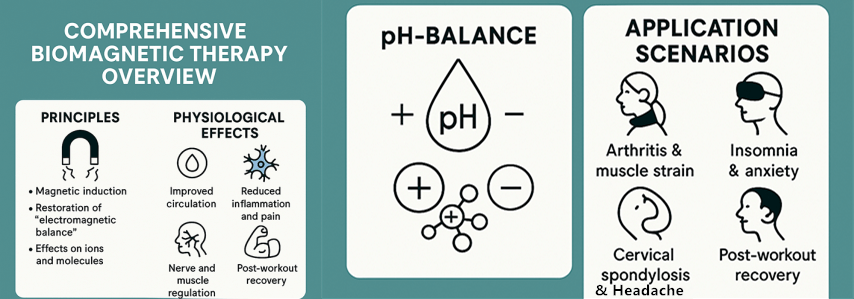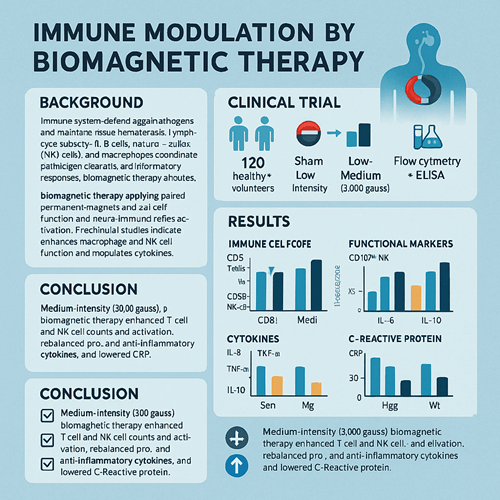Biomagnetic Therapy, as a non-invasive alternative medical approach, is gradually gaining attention and adoption worldwide. From basic principles through clinical practice to product selection, understanding its underlying mechanisms and real-world effects will help you evaluate and experience this innovative therapy scientifically. The following sections explain the basic principles of biomagnetic therapy, how magnetic fields affect the body, the pH-balance theory, practical application scenarios, and a guide to choosing products.
I. Origins and Development of Biomagnetic Therapy
Background
In the mid-20th century, scientists discovered that living tissues carry very weak bioelectric currents and theorized these currents were closely linked to health. Some early practitioners began combining external magnetic fields with the body to regulate its electromagnetic balance, thus coining the concept of “biomagnetic therapy.”
Timeline of Development
- 1960s–1970s: Foundational research deepened, with initial experiments showing that localized magnetic fields could improve blood flow and tissue repair.
- 1980s–1990s: Wearable magnetic devices emerged, enabling small-scale clinical trials.
- 2000s–Present: Advances in materials science, magnet manufacturing, and medical imaging introduced high-strength rare-earth magnets (e.g., NdFeB) into biomagnetic products, significantly enhancing both efficacy and safety.
II. Basic Principles of Biomagnetic Therapy
The core hypothesis of biomagnetic therapy is that healthy and diseased tissues exhibit different electrical-magnetic characteristics. By applying an external magnetic field, one can help restore electromagnetic balance in tissues, thereby improving function or relieving symptoms. The main principles can be summarized in three parts:
- Bioelectric Currents and Magnetic Induction
- Existence of Bioelectricity: Ion gradients across cell membranes (Na⁺, K⁺, Ca²⁺) create micro-currents when cells are active.
- Magnetic Induction: According to Faraday’s law, a static or changing magnetic field acting on conductive media (iron ions in blood, electrolytes in tissue) induces tiny currents or alters ion trajectories. These add to the body’s own micro-currents, fine-tuning membrane potentials and influencing cell function.
- Effects on Ions and Molecules
- Iron-Ion Magnetization: Hemoglobin’s iron (Fe²⁺/Fe³⁺) is paramagnetic or mixed-magnetic. Moderate fields can reorient its magnetic moments, aiding blood flow and improving oxygen delivery.
- Polar Molecule Alignment: Water and other polar molecules align in a magnetic field, forming chains that theoretically enhance intercellular exchange and signal transmission.
- Restoration of “Electromagnetic Balance”
- Healthy Balance: In ideal health, tissues maintain a stable dynamic between membrane potentials and local magnetic fields.
- Disease-Induced Imbalance: Inflammation, injury, or chronic illness disrupts membrane potentials and ion-channel function, causing pain, swelling, or metabolic dysfunction.
- Magnetic Field Intervention: Targeted magnetic patches or devices “compensate” for the disrupted potential at the lesion or acupoint, restoring normal ion flow, improving cell metabolism, and promoting tissue repair.
III. Major Physiological Effects of Magnetic Fields
Scientific studies and clinical observations show that biomagnetic therapy can influence the body in multiple ways:
- Enhancing Blood and Lymphatic Circulation
- Vasodilation: Magnetic fields stimulate vascular smooth muscle, improving local vessel tone and microcirculation.
- Improved Transport: Better blood flow delivers more oxygen and nutrients while speeding removal of waste (lactic acid, toxins).
- Lymphatic Return: Magnetic stimulation of lymphatics reduces edema and helps immune cells clear pathogens more effectively.
- Reducing Inflammation and Pain
- Inflammatory Mediator Modulation: Research indicates magnetic fields can alter the release of prostaglandins, interleukins, and other inflammatory mediators, lowering local inflammation.
- Gate-Control Theory: According to the gate-control theory of pain, a strong stimulus can “close” pain signal pathways. A moderate magnetic stimulus at nerve endings interferes with pain transmission, reducing perceived pain.
- Regulating Nervous and Muscular Function
- Neuronal Excitability Balance: Magnetic fields affect nerve-cell depolarization and repolarization, helping rebalance hypertonic or hypotonic muscles.
- Neurotransmitter Release: Studies show magnetic fields can influence levels of dopamine, serotonin, and other neurotransmitters, modulating mood, sleep, and stress.
- Promoting Tissue Repair and Antioxidation
- Cell Regeneration: By improving local oxygenation and nutrient supply, magnetic fields support cell proliferation and differentiation, accelerating wound healing.
- Antioxidant Effects: Magnetic stimulation may activate enzymes such as superoxide dismutase, reducing free-radical damage to cells.
IV. pH-Balance Theory
Body-fluid pH (blood ~7.35–7.45) remains tightly regulated. Chronic acidity weakens immunity, disrupts metabolism, and can lead to disease. Biomagnetic therapy helps maintain or restore pH balance by:
- Redistribution of Alkaline Minerals: Ca²⁺, Mg²⁺, K⁺ more readily cross cell membranes under magnetic influence, repairing damaged ion channels and enhancing neutralization of acidic by-products.
- Improved Local Metabolism: Enhanced blood and lymph flow rapidly carry away lactic acid and other acidic metabolites, preventing local acidosis.
- Activation of Alkaline Enzymes: Some pH-regulating enzymes (e.g., carbonic anhydrase) increase activity under moderate fields, helping stabilize pH in blood and interstitial fluids.
V. Practical Application Scenarios
Biomagnetic therapy can be delivered in various product forms according to need and target area:
| Product Form | Primary Use | Recommended Usage |
|---|---|---|
| Magnetic Patches | Local pain, inflammation | Apply to the pain point for 20–30 minutes, 1–3× daily |
| Magnetic Wrist/Anklets | Joint issues, circulation | Wear on wrist or ankle during sleep or daily |
| Magnetic Neck Wrap/Eye Mask | Cervical discomfort, insomnia | 10–20 minutes to relax nerves |
| Magnetic Mattress/Pillow | Whole-body conditioning, sleep quality | Continuous, covering large-area acupoints |
Typical Use Cases
- Arthritis & Muscle Strain: Apply patches directly to the painful area, combining with gentle massage to noticeably relieve pain and swelling.
- Cervical Spondylosis & Headache: A magnetic neck wrap restores microcirculation around the neck, reduces compression and inflammation, and helps relax nerves.
- Insomnia & Anxiety: A magnetic eye mask creates a mild field that promotes melatonin secretion and deepens sleep; wearing a magnetic wristband also eases tension.
- Post-Workout Recovery: Using patches or magnetic supports after exercise accelerates lactic acid metabolism and alleviates muscle soreness.
By understanding these principles and selecting the appropriate product form and strength, you can safely integrate biomagnetic therapy into your health regimen. Whether seeking pain relief, better sleep, or faster recovery, the right magnetic solution—used properly—can deliver tangible benefits.




